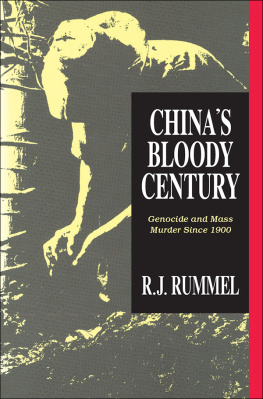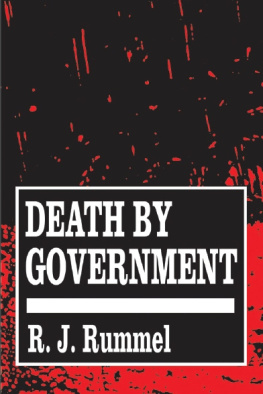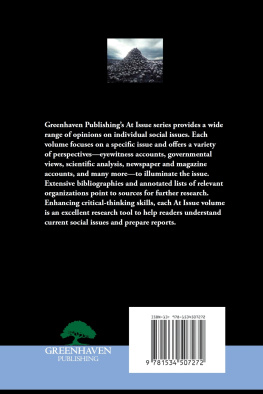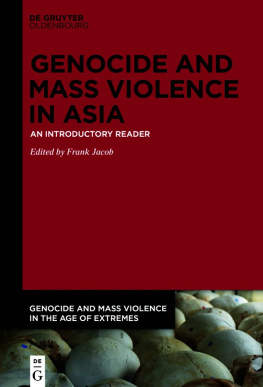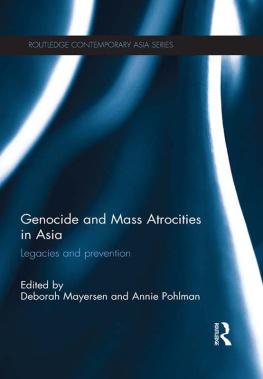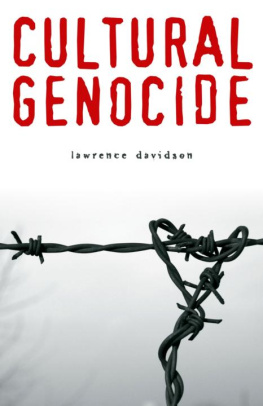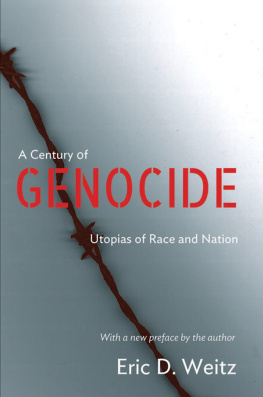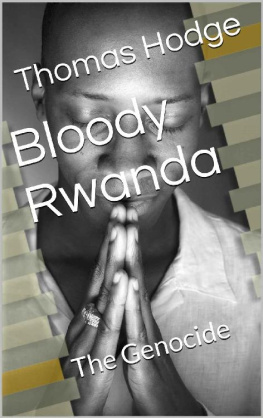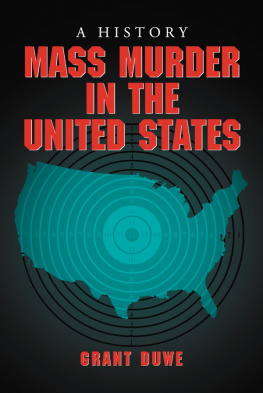First published 1991 by Transaction Punlishers
Published 2017 by Routledge
2 Park Square, Milton Park, Abingdon, Oxon OX14 4RN
711 Third Avenue, New York, NY 10017, USA
Routledge is an imprint of the Taylor & Francis Group, an informa business
Copyright 1991 by Taylor & Francis.
All rights reserved. No part of this book may be reprinted or reproduced or utilised in any form or by any electronic, mechanical, or other means, now known or hereafter invented, including photocopying and recording, or in any information storage or retrieval system, without permission in writing from the publishers.
Notice:
Product or corporate names may be trademarks or registered trademarks, and are used only for identification and explanation without intent to infringe.
Library of Congress Catalog Number: 90-47706
Library of Congress Cataloging-in-Publication Data
Rummel, R. J. (Rudolph J.). 1932-
Chinas bloody century : genocide and mass murder since 1900 / R. J. Rummel.
p. cm.
Includes bibliographical references and index.
ISBN 978-1-4128-0670-1 (alk. paper)
1. ChinaHistory20th century. 2. GenocideChinaHistory20th century. I. Title.
DS774.R86 1991
951.05dc20 90-47706
CIP
ISBN 13: 978-1-4128-0670-1 (pbk)
Contents
Figures and Tables
Preface
R. J. Rummel
This work on China is the second volume of three on the genocide and mass murder by governments in our century. The first, Lethal Politics, on the Soviet Union has recently been published,
Such democide has been far more prevalent than people have believed, even several times greater than the number killed in all of this centurys wars. Just consider that alone 61,911,000 people were murdered by the Soviet Union; 38,702,000 by the Chinese communists; 22,000,000 (preliminarily) by the German Nazis; 10,214,000 by the Chinese Nationalists; and 5,890,000 by the Japanese militarists during World War II. This does not even exhaust the list of this centurys mega-murderers, which also would include the past governments of Turkey, Cambodia, Pakistan, Yugoslavia; nor does it include the lesser killers responsible for hundreds of thousands of corpses each, such as past governments of Uganda, Indonesia, Albania, Burundi, Czechoslovakia, Ethiopia, Hungary, Rumania, Spain, and Vietnam. Then there are the numerous third-class murderers who have only killed in the tens of thousands. In sum, well over 100 million people have been murdered by their governments since 1900, several times greater than the 35,654,000 battle-dead from all the foreign and domestic wars fought in these years, including World Wars I and II.
Many explanations have been offered for such killing, but I contend that most fundamentally the root cause is arbitrary, undisciplined power in the hands of tyrants; that wherever such power has been centralized and unchecked, the possibility exists that it will be used at the whim of dictators to kill for their own ends, as by a ruling group for ethnic-racial purity, national unity, or greater national glory, or by a doctrinaire party for development, equality, or utopia.
The flip side of this is that where power is restrained, balanced, and checked, mass murder is relatively rare. Indeed, I believe that there is a strong inverse relationship between democratic institutions that restrain and discipline power, and the extent of government killing, whether that in domestic or foreign war and violence, or in genocide or mass murder. The more democratic and less totalitarian or authoritarian a state, the less government killing; the less democratic and more totalitarian or authoritarian a state, the more government killing. I have found this to be true for warfare, and the basic purpose of this and the other two books mentioned above is to determine whether it also holds for genocide and mass murder. The evidence so far suggests that it does. The most rigorously totalitarian countries in the world, Stalins Soviet Union, Hitlers Germany, Maos China (as will be shown here), and Pol Pots Cambodia have also been this centurys greatest killers. What must be further explored, however, is whether in fact the correlation holds up when all cases of democide in this century are analyzed. Assessing this will be the onus of the next volume.
The primary purpose of this work on China, however, is to estimate the number of people killed in cold blood for the various governments that China has had since 1900. While this is basically a statistical aim, the development of these statistics and their understanding could not be left to a simple statistical and methodological elaboration. To fully develop the statistical estimates required comprehending their human context; to explain why this killing occurred, necessary if the role of power is to be unravelled, required embedding the estimates in their history. But at the same time, whatever totals were determined had to be carefully documented and statistically justified if others were to have any confidence in them and build on this work.
Accordingly, I layer this book in the same way as I did the one on Soviet democide. Its chapters present successive periods in the history of China, with each chapter being divided into three basic parts. The first presents the history of the period, within which the nature and amount of democide and other forms of killing are presented. The second is a detailed statistical table giving the basic democide estimates and their sources and qualifications, and my calculations of sub-totals and totals for the period. And the third is an appendix that explains, elaborates, and justifies the computations and estimates I make in the statistical table. Both this table and appendix are prepared for those professionally interested in the statistics and can be ignored by those who simply want to read about the democide and its history and context. This part is meant to stand on its own.
I had to violate this organization for the chapters on the Peoples Republic of China (PRC), however. Because of the need to carry out some calculations through each of the periods from 1949 to 1987, especially for forced labor dead, the estimates and calculations of communist democide are included in one very large table (table II.1), which is then prefaced with an equally detailed appendix describing what was done (appendix II.1). Because of this arrangement, the book is divided into two parts. The first considers the periods up to the Peoples Republic of China, the second part covers the subsequent periods.
The book begins in if their elaboration for the PRC is desired.
A methodological appendix at the end of this book presents some of the major principles and techniques underlying the estimation process; it is virtually identical to the one appearing in the book on Soviet democide, except for an important revision in the definition of democide (I now accept indiscriminate urban bombing as democide). It also presents the overall philosophy governing the estimation process. For those curious as to how I could dare assert anything like the communists probably murdered 38,702,000 people for a country with such awful statistics, where even population estimates for all the years up to the 1960s varied widely by hundreds of millions, the methodological appendix should be a helpful orientation before reading or using the rest of this book.


